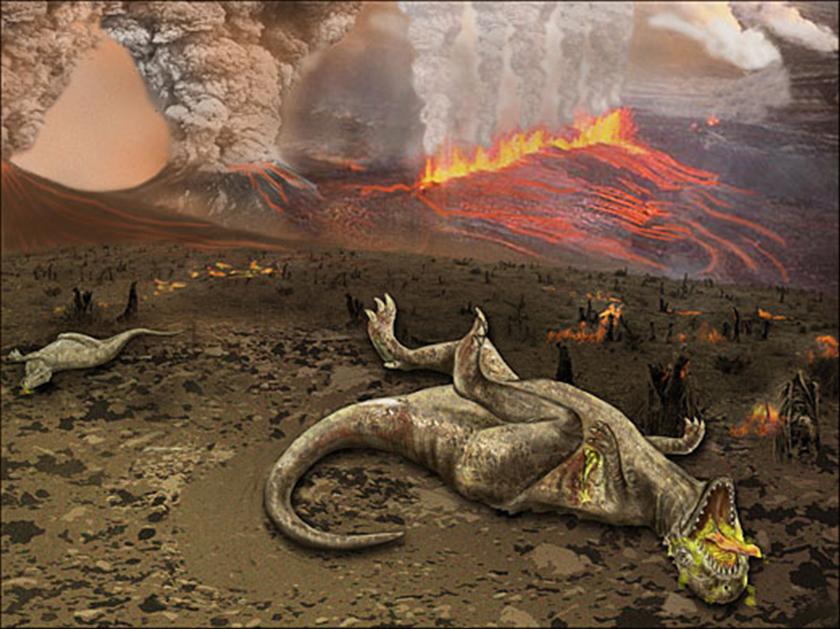©Copyright 2018 GEOSCIENCE RESEARCH INSTITUTE
11060 Campus Street • Loma Linda, California 92350 • 909-558-4548

Chiarenza, AA, A Farnsworth, PD Mannion, DJ Lunt, PJ Valdes, JV Morgan, and PA Allison. 2020. Asteroid impact not volcanism, caused the end-Cretaceous dinosaur extinction. Proceedings, National Academy of Sciences www.pnas.org/cgi/doi/10.1073/pnas.2006087117.
Summary. Dinosaur fossils are widespread in Mesozoic sediments, but are absent from the overlying Cenozoic sediments. There is debate over the cause of their extinction. The best-known explanation is that a 10-km (6-mile) diameter asteroid struck the earth near present-day Mexico’s Yucatan Peninsula at a site called Chicxulub. This impact is calculated to have produced a cloud of dust and gases that blocked the sun and caused a severe cooling that killed the dinosaurs. Another explanation for dinosaur extinction is that extensive volcanism of the Deccan Traps in India generated atmospheric gases that caused climate change and killed the dinosaurs. Extensive volcanism has been linked to the end-Permian and end-Triassic mass extinctions, and is considered a likely contributor to the demise of the dinosaurs in the end-Cretaceous mass-extinction. Previous discussions of these two potential mechanisms have focused on fossil patterns and event simulations, but have not attempted to model the link between dinosaur habitat suitability and the relative climatic effects of the volcanism and impact scenarios.

Artist’s rendition of dinosaur extinction due to volcanism from the Deccan Traps of India.
Image: National Science Foundation, Public Domain, Zina Deretsky.
This paper compares inferred dinosaur habitat requirements with simulations of the Deccan volcanism and the Chicxulub impact. Simulations show that a solar dimming of >15% would destroy all suitable habitat for dinosaurs and directly cause their extinction.
In the simulations, volcanism from the Deccan Traps would not produce changes in climate sufficient to completely destroy the dinosaurs. The extended duration of the volcanism would have produced up to a 5% solar dimming, which could reduce average temperatures by up to about 9.7 oC. This would leave at least some suitable habitat in the tropics where dinosaurs could survive.
The Chicxulub asteroid impact would generate large amounts of SO2 and CO2, which would be injected into the atmosphere. In the simulations, SO2 would block the sunlight sufficiently to cause solar dimming of >15%, cooling the atmosphere within five years to temperatures below freezing (-34.7 oC) for 3-16 years. This would completely destroy all habitat suitable for dinosaurs and cause their extinction. According to these calculations, the impact hypothesis, but not the volcanic hypothesis, is sufficient to explain the extinction.
Comment. The global nature of dinosaur extinction calls for an explanation that is global in nature. Volcanism and extraterrestrial impacts may be part of that explanation, but there are reasons to question the standard scenario of extinction due to impact. A major problem is the selectivity of the extinctions. What kind of event would be catastrophic enough to destroy every dinosaur on earth but leave survivors among the crocodilians, frogs, snakes, birds, mammals, flowering plants, and many other groups? None of these groups would have any chance of surviving 3-16 years of continuous sub-freezing global temperatures as proposed in the paper.[1]
Abrupt changes in fossil types occur throughout the fossil record. In five cases, at least 75% of the species in one layer are absent in the overlying layers. These abrupt changes in fossil content are interpreted as mass extinctions. Two of these mark major boundaries in the geologic column. The end-Permian mass extinction marks the boundary between Paleozoic and Mesozoic layers, and the end-Cretaceous mass extinction marks the boundary between the Mesozoic and Cenozoic layers.
Controversy surrounds the causes of the “big five” mass extinctions. The three causes most widely discussed are: extraterrestrial impacts[2], especially for the Cretaceous-Paleogene extinction; huge volcanic flows (documented by large igneous provinces)[3]; and sea-level changes.[4] Each of these proposed causes has some support and some problems, and none of them has achieved consensus status.
An alternative explanation is that all three factors were involved in the global catastrophe described in Genesis 7-8, In this scenario, mass extinctions, including the one associated with extinction of the dinosaurs, are not discrete events separated by millions of years, but are part of a continuous process of sequential destruction of habitats. Abrupt changes in source areas, perhaps associated with effects of rapid plate subduction, extraterrestrial impacts, or volcanic outflows, could produce the abrupt changes in fossil content commonly interpreted as mass extinctions. Much research remains to be done in order to develop a satisfactory explanation of the geologic column, but advances are being made as more data become available and more scientists analyze the evidence from a biblical viewpoint.[5] Regardless, models that support instantaneous to very rapid mass extinction, such as the impact scenario, fit better with a short chronology approach than models entailing protracted and gradual deterioration of ecosystems over thousands to tens of thousands of years.
References
[1] Another research group proposes that soot from burning vegetation would reduce light below the level needed for photosynthesis. Tabor, CR, CG Bardeen, BL Otto-Bliesner, RR Garcia, and OB Toon. Causes and climatic consequences of the impact winter at the Cretaceous-Paleogene boundary. Geophysical Research Letters 47(3), 16 February 2020, e60121, https://doi.org/10.1029/2019GLO85572.
[2] Napier, WM. 2014. The role of giant comets in mass extinctions. Pp 383-395 in (G Keller and AC Kerr, eds.) Volcanism, Impacts, and Mass Extinctions: Causes and Effects: Geological Society of America Special Paper 505, p. 29–55, https://doi.org/10.1130/2014.2505(02)
[3] Rampino, MR and RB Stothers. 1988. Flood basalt volcanism during the past 250 million years. Science 241:663-668, 05 Aug 1988, DOI: 10.1126/science.241.4866.663. Bond, DPG and PB Wignall. 2014. Large igeneous provinces and mass extinctions: An update. Pp 29-55 in (G Keller and AC Kerr, eds.) Volcanism, Impacts, and Mass Extinctions: Causes and Effects: Geological Society of America Special Paper 505, p. 29–55, https://doi.org/10.1130/2014.2505(02)
[4] Peters, SE. 2008. Environmental determinants of extinction selectivity in the fossil record. Nature 454:626-629. Doi:10.1038/nature07032.
[5] See, for example, the recent book by T. Clarey, Carved in Stone, https://www.grisda.org/carved-in-stone